Walter Christopher Hebbe
The Children of William and Mattie Hebbe:
Walter
Walter Christopher Hebbe was born 23 March 1893 in Jefferson County,
Kansas and died 24 July 1935 while harnessing his team of mules
near Dover, Kingfisher County, Oklahoma. He was the only grandson
of Christoph and Sophia who carried the Hebbe surname. On 22
December 1914 he married Fern Alma Miller, who was born 19 Sept 1892 at Belle
Plaine, Kansas, and died on 23 November, 1983 at Wellington, Kansas. Walter and Fern had
two daughters: Eileen June (1916-1998) and Glendon Jean
(1918-2003).
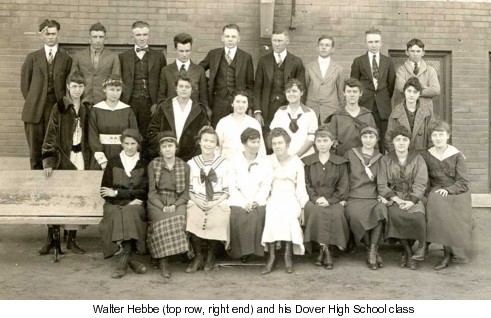 Walter was 13 when he and Irene (then 15) completed the 1906 school
term at Potter
Public School. Walter worked toward his high school
diploma at Dover High School where he was a lackluster student (as
suggested by his poor handwriting and many spelling errors) but
received awards for perfect
attendance. The qualifying test for his
diploma
was taken April 27, 1910; although he appears to
have fallen short of the officially required average of 75
percent, he did go on to
business college that fall. We have exam papers from the Franklin
Institute, a correspondence school; perhaps those studies were to
bolster his academic credentials.
Walter was 13 when he and Irene (then 15) completed the 1906 school
term at Potter
Public School. Walter worked toward his high school
diploma at Dover High School where he was a lackluster student (as
suggested by his poor handwriting and many spelling errors) but
received awards for perfect
attendance. The qualifying test for his
diploma
was taken April 27, 1910; although he appears to
have fallen short of the officially required average of 75
percent, he did go on to
business college that fall. We have exam papers from the Franklin
Institute, a correspondence school; perhaps those studies were to
bolster his academic credentials.
Just as we suspect Christoph
pressured
Will, unsuccessively, to become a full time carpenter, Glendon related
that Will really wanted Walter to become a lawyer. Will saw the
Business College in Guthrie as a step in that direction. Walter
dutifully earned a diploma from the business college. However, “Dad
loved the soil and all aspects of farming and he did not like some of
the things [i.e., subjects] being taught him in Business College. He had a
distrust of lawyers which he carried all of his life. After he
completed his courses, he still wanted to farm the land and asked his
parents what they wished for him: to become a crooked lawyer, or
a farmer?”
We have no letters written by Walter, but do have several picture postcards.
We suspect colorful postcards were the preferred medium in good
part for their appeal to his little sister Delma, on whom the
family doted. Walter wrote few specifics about his time in Guthrie to
his mother and six-year-old sister Delma. September 1, 1910: “I am getting along fine. Like bookkeeping best. I’ll be home in a month or two.” September 29: “are
you going to school yet. write and tell me about your teacher. Have you
rode old ladie much and how is the colt … tell me what you want
when I come home.” November 15, 1910: “are
you coming over with papa when he comes? Say Delma tell Mamma to send
my Dictionery with Papa, be sure to come along with him.” November 22: “Why
didn’t you come with Papa? How do you like school? I‘ll be
home xmas. … what reader you in this yer?”
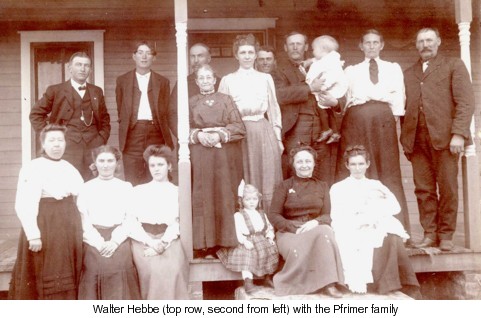 Walter’s job or jobs took him around Kansas
the next several months. From Herington June 25, 1912:
“Dear Sister! How is everyone down there. I am feeling good
… How is the colt? Everything looks good here. Has Mamma got any
chickens big enough to eat.” Belleville February 7,
1913: “Dear Mother am feeling fine with a frozen chin. Got
a card from Irene today I guess she thinks it is cold up here but is
warmer now … I hear you was lonesome with us both gone. How
about it?” The stamped return address on the
envelope reads Rock Island Lines, Herington, Kans. But
Walter’s letter begins: “Hyton Kans 3/27/13
… Dear Mother, I received your welcome letter … was glad
to hear from you … How is Dad? Is he any better than he was?
… am working all the time. Got myself some new cloths the other
day got so many now don’t know where they all are. Guess I will
save my money may need it some day if I don’t it is nice thing to
have … I will make about $85.00 this month that is better lots
of other jobs isnt? Think I will go back to Belleville this summer and
stay there. What is Delma going to do with her day? … I will try
and write oftener after this. W.C.H.”
Walter was back
in the Dover area by Christmas that year. He and "Roscoe" (presumably
Roscoe Pfrimer, and a friend) appear (top left) in a picture taken
at the Pfrimers' holiday party. The Pfrimers were
neighbors “and just friends” according to Walter’s
daughter Glendon.
Walter’s job or jobs took him around Kansas
the next several months. From Herington June 25, 1912:
“Dear Sister! How is everyone down there. I am feeling good
… How is the colt? Everything looks good here. Has Mamma got any
chickens big enough to eat.” Belleville February 7,
1913: “Dear Mother am feeling fine with a frozen chin. Got
a card from Irene today I guess she thinks it is cold up here but is
warmer now … I hear you was lonesome with us both gone. How
about it?” The stamped return address on the
envelope reads Rock Island Lines, Herington, Kans. But
Walter’s letter begins: “Hyton Kans 3/27/13
… Dear Mother, I received your welcome letter … was glad
to hear from you … How is Dad? Is he any better than he was?
… am working all the time. Got myself some new cloths the other
day got so many now don’t know where they all are. Guess I will
save my money may need it some day if I don’t it is nice thing to
have … I will make about $85.00 this month that is better lots
of other jobs isnt? Think I will go back to Belleville this summer and
stay there. What is Delma going to do with her day? … I will try
and write oftener after this. W.C.H.”
Walter was back
in the Dover area by Christmas that year. He and "Roscoe" (presumably
Roscoe Pfrimer, and a friend) appear (top left) in a picture taken
at the Pfrimers' holiday party. The Pfrimers were
neighbors “and just friends” according to Walter’s
daughter Glendon.
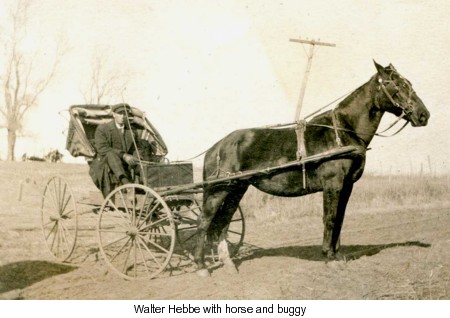 Glendon related how her parents met during the summer of 1914. Fern’s
parents, William and Nannie Miller, rented the farm adjoining (on the east) William and Mattie Hebbe's
farm. “Mom and a
sister were hoeing cotton in one field while keeping an eye on the good
looking boy doing the same chore in the adjoining field. Walter stopped
hoeing long enough to pick a watermelon from a nearby patch and set it
in a shady spot to cool down. When he was at the other end of the
field, Mom and her sister sneaked over and took the watermelon.
Later when he searched for it, they called for him to come over and get
it. Instead, he turned his back on them and went home.
Later, when Mom apologized for their actions, he explained his reason
for not coming on over was, he had a hole in the seat of his pants!"
Glendon related how her parents met during the summer of 1914. Fern’s
parents, William and Nannie Miller, rented the farm adjoining (on the east) William and Mattie Hebbe's
farm. “Mom and a
sister were hoeing cotton in one field while keeping an eye on the good
looking boy doing the same chore in the adjoining field. Walter stopped
hoeing long enough to pick a watermelon from a nearby patch and set it
in a shady spot to cool down. When he was at the other end of the
field, Mom and her sister sneaked over and took the watermelon.
Later when he searched for it, they called for him to come over and get
it. Instead, he turned his back on them and went home.
Later, when Mom apologized for their actions, he explained his reason
for not coming on over was, he had a hole in the seat of his pants!"
It all worked out well, for the two were married December 22, 1914. We wonder, might he have courted Fern in this smart-looking buggy?
Glendon said Walter and Fern affectionately called their first farm
“the sticks.” The September 24, 1915 rental agreement
reads in part: “I will lease you my farm for 3 years,
allowing you to make the repairs you suggest on the terms you
mention. … requesting you be as economical as
possible. Please send all receipts to me which you receive for the
material you buy and pay for. The rent, always payable in advance, will
be $150 cash. Of course, you will deduct first the cost of the repairs.
I think it will be all right to line the inside with wide boards and
paper over that as you suggest. This ought to make the house much
warmer. By all means, have the well fixed. Also, please see that the
windmill is protected, and secure a new sandpoint if one is needed. The
house ought to be painted outside. … I accept your agreement to
act as my agent. … to care for the place as though it were
your own, and pay my taxes in Kingfisher once a year.” The
"sticks" is where both daughters were born, but they moved nine days
after Glendon’s birth.
On January 27, 1919 W. C. Hebbe and Walter Hebbe jointly purchased 160
acres from W. I. and Mary J. Loch for $7,000. [Kingfisher Co.
Deed Bk 58 page 518] This was the same farm Fern’s parents
had rented in 1914 and was where she was living when she and Walter
met. According to Walter’s daughter Glendon: "This
was co-owned by my folks and grandparents, but my folks did the farming
and paid all the interest and taxes. They never were able to pay much
on the principal. Grandpa & Grandma received half the gross,
but didn’t pay for seed & such." The mortgage
was renewed several times. In 16 years working the farm, Walter and
Fern managed to pay only $2000 towards the principal.
Glendon wrote an article in which she recounted memories of her father: “Dad
loved animals and one of my earliest recollections of him was his
tending to the needs of the livestock. He was always building sheds for
them and in the winter months made sure they had plenty of straw to bed
down in. He took good care of the animals but often became so fond of
an animal, he couldn’t bear to sell it so kept it far past its
usefulness. He chose mules instead of horses because he thought they
made better workers. My grandfather had horses for he liked them
better. There was a strong difference of opinion on this between the
two. Dad had only one tractor in his lifetime; when he sold it,
he said: I’m under it repairing it more than I’m on
it.” It seems he traded the tractor for mules. The ironic
thing is, he usually finished working the fields before neighbors with
tractors did. Pictures of farm work in those years can be seen here.
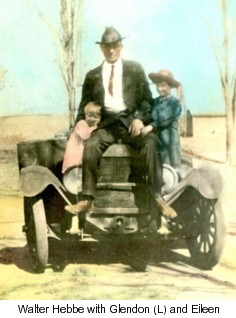 He was quite inventive and was always
constructing something to make our life easier. We enjoyed a lot of
conveniences that other farmers did not have. He was more inventive
than he was mechanical-minded. He had one steam engine he bought to use
to operate a threshing machine. He was going to thresh wheat for others
to add to his income. This turned out to be a disaster. The engine was
so large and cumbersome it traveled only five miles an hour and usually
took a day to move from one place to another.
He was quite inventive and was always
constructing something to make our life easier. We enjoyed a lot of
conveniences that other farmers did not have. He was more inventive
than he was mechanical-minded. He had one steam engine he bought to use
to operate a threshing machine. He was going to thresh wheat for others
to add to his income. This turned out to be a disaster. The engine was
so large and cumbersome it traveled only five miles an hour and usually
took a day to move from one place to another.
The first car I can remember was a
Model T Ford pickup. It had a fabric top, hand-operated windshield
wiper, and isinglass curtains to put up in bad weather. … He
drove this for a long time, its fabric top rotted and flapping in the
wind. The truck had to be cranked with a hand crank and was hard to
start. One time the weather was so cold and the motor so stiff he
couldn’t crank it. He built a small bonfire under the motor to
warm it and nearly burnt it up before we could push it away from the
fire. … The next car he had was a new 1928 Pontiac. It was
beautiful, but troublesome from the beginning. … It often died
while driving down the road. He finally had the carburetor replaced
with one from a Model T and that ended the trouble.”
[Note: the car pictured here is not a Model T; perhaps there was an old car Glendon was too young to remember.]
Walter’s sudden death was a shock to the entire community. Glendon remembered: “Harvest
was just over and Dad wasn’t feeling well so I drove him to see
the doctor. He told us the doctor said he almost had dust pneumonia
from shoveling the wheat. Early the next morning he suffered a massive
fatal heart attack." The first news of
his death,
published in the Hennessey Clipper July 25, 1935, gave these
details: “He was stricken at 6:20 a.m. while preparing to
hitch up his team to start listing at his place, one mile north and
three-quarters east of Dover. His lifeless body was discovered by a
daughter who had gone to the barn to summon him to the
telephone.”
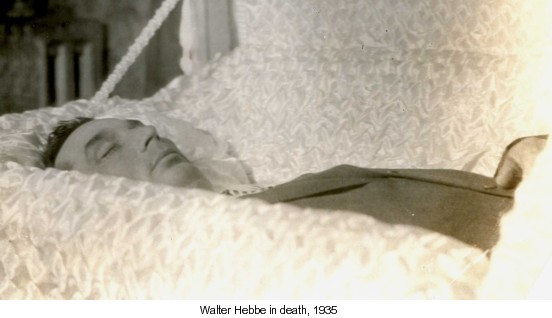
By late August Fern, as administratrix of Walter’s estate, had
filed an inventory of everything he owned at the time. The value
appears to be what the object sold for at the estate sale held that
same month. His undivided ½ interest in the 160 acre tract was
valued at $5000, which was the amount of the latest mortgage. He
had 23 head of cattle, 3 mules, farm machinery, household goods, 40
head of shoats, 500 bushel of wheat, 175 bushel of oats, hay and
chickens. Of those, the cattle and wheat were of greatest value.
Glendon related: “It was
a terrible shock and tragedy for all the family and Mom said she
didn’t see how she could possibly carry on without him. She knew
we couldn’t remain on the farm and she wanted Eileen and me to
continue with our education. The farm was sold and there was a large
farm sale. Prices were low in those days and the farm still had a large
debt against it so not much money was netted from the sale. Late in
August, Mom moved us to Stillwater, Oklahoma, where she had rented a
house. She took in four “boarders” -- two to four students,
and once it was two students and two businessmen. Eileen and I enrolled
at Oklahoma A&M College. This [first boarding house]
wasn’t a paying venture so the next summer we moved into an even
larger house and rented rooms to 6-8 students. [As fate would have it,
one of them became Glendon's husband.] Mom worked at whatever job she
could find. This still didn’t pay enough to meet all our expenses
so she decided to move nearer her parents and siblings in Wellington,
Kansas. She rented out the upstairs of a large house and Eileen
and I took whatever job we could find. Two years later Mom purchased an
apartment house, moved into one apartment and rented out the other
three. This was her home for the next forty years.”
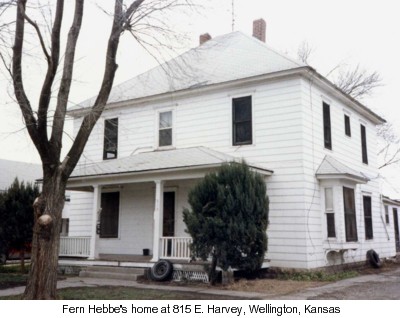 |
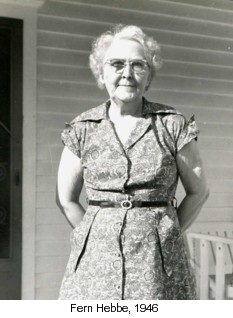 |
Fern worked outside the house as well as being a landlady. In wartime she worked at a defense plant. She was
a long-time employee of the Wellington hospital. Her income was always
modest, but she was frugal and managed her money well. Family helped
with house repairs and improvements.
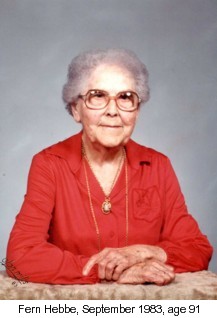 In Fern's last years she resided in an apartment in a high-rise
for senior citizens. This arrangement eased the minds of her daughters,
because Fern's heart trouble and other afflictions of old age were constant
concerns. Fern enjoyed chatting with her new neighbors. The custom
of the residents was to open their apartment doors in the morning as a
sign they were all right. One morning Fern's door stayed closed,
sparking worry among the neighbors. They found her slumped on the
floor. This heart attack had been fatal.
In Fern's last years she resided in an apartment in a high-rise
for senior citizens. This arrangement eased the minds of her daughters,
because Fern's heart trouble and other afflictions of old age were constant
concerns. Fern enjoyed chatting with her new neighbors. The custom
of the residents was to open their apartment doors in the morning as a
sign they were all right. One morning Fern's door stayed closed,
sparking worry among the neighbors. They found her slumped on the
floor. This heart attack had been fatal.
The picture here was taken two months before her death.
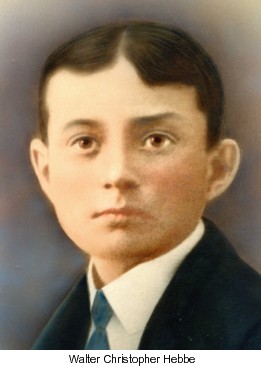

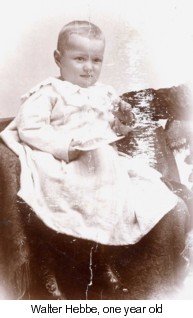
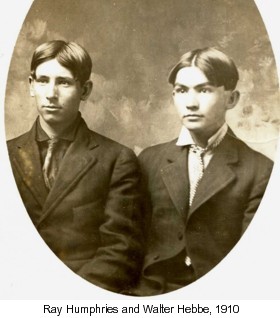
 Walter was 13 when he and Irene (then 15) completed the 1906 school
term at Potter
Public School. Walter worked toward his high school
diploma at Dover High School where he was a lackluster student (as
suggested by his poor handwriting and many spelling errors) but
received awards for perfect
attendance. The qualifying test for his
diploma
was taken April 27, 1910; although he appears to
have fallen short of the officially required average of 75
percent, he did go on to
business college that fall. We have exam papers from the Franklin
Institute, a correspondence school; perhaps those studies were to
bolster his academic credentials.
Walter was 13 when he and Irene (then 15) completed the 1906 school
term at Potter
Public School. Walter worked toward his high school
diploma at Dover High School where he was a lackluster student (as
suggested by his poor handwriting and many spelling errors) but
received awards for perfect
attendance. The qualifying test for his
diploma
was taken April 27, 1910; although he appears to
have fallen short of the officially required average of 75
percent, he did go on to
business college that fall. We have exam papers from the Franklin
Institute, a correspondence school; perhaps those studies were to
bolster his academic credentials. Walter’s job or jobs took him around Kansas
the next several months. From Herington June 25, 1912:
“Dear Sister! How is everyone down there. I am feeling good
… How is the colt? Everything looks good here. Has Mamma got any
chickens big enough to eat.” Belleville February 7,
1913: “Dear Mother am feeling fine with a frozen chin. Got
a card from Irene today I guess she thinks it is cold up here but is
warmer now … I hear you was lonesome with us both gone. How
about it?” The stamped return address on the
envelope reads Rock Island Lines, Herington, Kans. But
Walter’s letter begins: “Hyton Kans 3/27/13
… Dear Mother, I received your welcome letter … was glad
to hear from you … How is Dad? Is he any better than he was?
… am working all the time. Got myself some new cloths the other
day got so many now don’t know where they all are. Guess I will
save my money may need it some day if I don’t it is nice thing to
have … I will make about $85.00 this month that is better lots
of other jobs isnt? Think I will go back to Belleville this summer and
stay there. What is Delma going to do with her day? … I will try
and write oftener after this. W.C.H.”
Walter was back
in the Dover area by Christmas that year. He and "Roscoe" (presumably
Roscoe Pfrimer, and a friend) appear (top left) in a picture taken
at the Pfrimers' holiday party. The Pfrimers were
neighbors “and just friends” according to Walter’s
daughter Glendon.
Walter’s job or jobs took him around Kansas
the next several months. From Herington June 25, 1912:
“Dear Sister! How is everyone down there. I am feeling good
… How is the colt? Everything looks good here. Has Mamma got any
chickens big enough to eat.” Belleville February 7,
1913: “Dear Mother am feeling fine with a frozen chin. Got
a card from Irene today I guess she thinks it is cold up here but is
warmer now … I hear you was lonesome with us both gone. How
about it?” The stamped return address on the
envelope reads Rock Island Lines, Herington, Kans. But
Walter’s letter begins: “Hyton Kans 3/27/13
… Dear Mother, I received your welcome letter … was glad
to hear from you … How is Dad? Is he any better than he was?
… am working all the time. Got myself some new cloths the other
day got so many now don’t know where they all are. Guess I will
save my money may need it some day if I don’t it is nice thing to
have … I will make about $85.00 this month that is better lots
of other jobs isnt? Think I will go back to Belleville this summer and
stay there. What is Delma going to do with her day? … I will try
and write oftener after this. W.C.H.”
Walter was back
in the Dover area by Christmas that year. He and "Roscoe" (presumably
Roscoe Pfrimer, and a friend) appear (top left) in a picture taken
at the Pfrimers' holiday party. The Pfrimers were
neighbors “and just friends” according to Walter’s
daughter Glendon.  Glendon related how her parents met during the summer of 1914. Fern’s
parents, William and Nannie Miller, rented the farm adjoining (on the east) William and Mattie Hebbe's
farm. “Mom and a
sister were hoeing cotton in one field while keeping an eye on the good
looking boy doing the same chore in the adjoining field. Walter stopped
hoeing long enough to pick a watermelon from a nearby patch and set it
in a shady spot to cool down. When he was at the other end of the
field, Mom and her sister sneaked over and took the watermelon.
Later when he searched for it, they called for him to come over and get
it. Instead, he turned his back on them and went home.
Later, when Mom apologized for their actions, he explained his reason
for not coming on over was, he had a hole in the seat of his pants!"
Glendon related how her parents met during the summer of 1914. Fern’s
parents, William and Nannie Miller, rented the farm adjoining (on the east) William and Mattie Hebbe's
farm. “Mom and a
sister were hoeing cotton in one field while keeping an eye on the good
looking boy doing the same chore in the adjoining field. Walter stopped
hoeing long enough to pick a watermelon from a nearby patch and set it
in a shady spot to cool down. When he was at the other end of the
field, Mom and her sister sneaked over and took the watermelon.
Later when he searched for it, they called for him to come over and get
it. Instead, he turned his back on them and went home.
Later, when Mom apologized for their actions, he explained his reason
for not coming on over was, he had a hole in the seat of his pants!"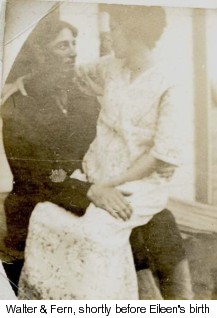
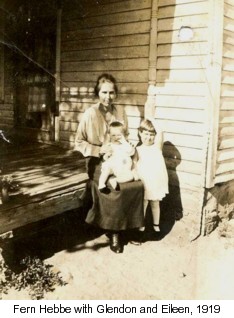
 He was quite inventive and was always
constructing something to make our life easier. We enjoyed a lot of
conveniences that other farmers did not have. He was more inventive
than he was mechanical-minded. He had one steam engine he bought to use
to operate a threshing machine. He was going to thresh wheat for others
to add to his income. This turned out to be a disaster. The engine was
so large and cumbersome it traveled only five miles an hour and usually
took a day to move from one place to another.
He was quite inventive and was always
constructing something to make our life easier. We enjoyed a lot of
conveniences that other farmers did not have. He was more inventive
than he was mechanical-minded. He had one steam engine he bought to use
to operate a threshing machine. He was going to thresh wheat for others
to add to his income. This turned out to be a disaster. The engine was
so large and cumbersome it traveled only five miles an hour and usually
took a day to move from one place to another. 


 In Fern's last years she resided in an apartment in a high-rise
for senior citizens. This arrangement eased the minds of her daughters,
because Fern's heart trouble and other afflictions of old age were constant
concerns. Fern enjoyed chatting with her new neighbors. The custom
of the residents was to open their apartment doors in the morning as a
sign they were all right. One morning Fern's door stayed closed,
sparking worry among the neighbors. They found her slumped on the
floor. This heart attack had been fatal.
In Fern's last years she resided in an apartment in a high-rise
for senior citizens. This arrangement eased the minds of her daughters,
because Fern's heart trouble and other afflictions of old age were constant
concerns. Fern enjoyed chatting with her new neighbors. The custom
of the residents was to open their apartment doors in the morning as a
sign they were all right. One morning Fern's door stayed closed,
sparking worry among the neighbors. They found her slumped on the
floor. This heart attack had been fatal.